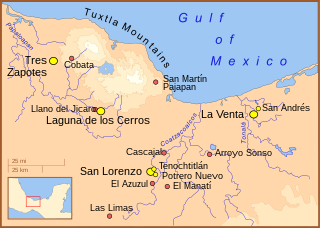
The Olmecs were the earliest known major Mesoamerican civilization. Following a progressive development in Soconusco, they occupied the tropical lowlands of the modern-day Mexican states of Veracruz and Tabasco. It has been speculated that the Olmecs derived in part from the neighboring Mokaya or Mixe–Zoque cultures.

Olmec figurines are archetypical figurines produced by the Formative Period inhabitants of Mesoamerica. While not all of these figurines were produced in the Olmec heartland, they bear the hallmarks and motifs of Olmec culture. While the extent of Olmec control over the areas beyond their heartland is not yet known, Formative Period figurines with Olmec motifs were widespread in the centuries from 1000 to 500 BC, showing a consistency of style and subject throughout nearly all of Mesoamerica.

Mesoamerican chronology divides the history of prehispanic Mesoamerica into several periods: the Paleo-Indian ; the Archaic, the Preclassic or Formative (2500 BCE – 250 CE), the Classic (250–900 CE), and the Postclassic (900–1521 CE); as well as the post European contact Colonial Period (1521–1821), and Postcolonial, or the period after independence from Spain (1821–present).
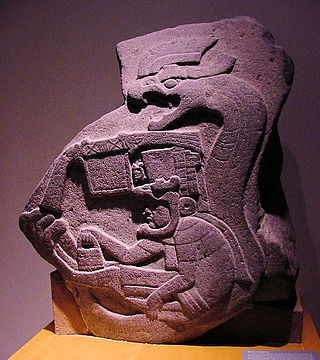
The religion of the Olmec people significantly influenced the social development and mythological world view of Mesoamerica. Scholars have seen echoes of Olmec supernatural in the subsequent religions and mythologies of nearly all later pre-Columbian era cultures.

Teopantecuanitlan is an archaeological site in the Mexican state of Guerrero that represents an unexpectedly early development of complex society for the region. The site dates to the Early to Middle Formative Periods, with the archaeological evidence indicating that some kind of connection existed between Teopantecuanitlan and the Olmec heartland of the Gulf Coast. Prior to the discovery of Teopantecuanitlan in the early 1980s, little was known about the region's sociocultural development and organization during the Formative period.
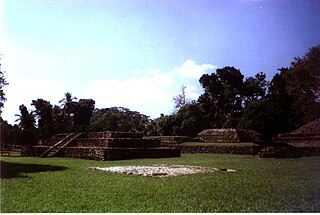
Izapa is a very large pre-Columbian archaeological site located in the Mexican state of Chiapas; it is best known for its occupation during the Late Formative period. The site is situated on the Izapa River, a tributary of the Suchiate River, near the base of the volcano Tacaná, the sixth tallest mountain in Mexico.

Tlapacoya is an important archaeological site in Mexico, located at the foot of the Tlapacoya volcano, southeast of Mexico City, on the former shore of Lake Chalco. Tlapacoya was a major site for the Tlatilco culture.

San Lorenzo Tenochtitlán or San Lorenzo is the collective name for three related archaeological sites—San Lorenzo, Tenochtitlán and Potrero Nuevo—located in the southeast portion of the Mexican state of Veracruz. Along with La Venta and Tres Zapotes, it was one of the three major cities of the Olmec, and the major center of Olmec culture from 1400 BCE to 900 BCE. San Lorenzo Tenochtitlán is best known today for the colossal stone heads unearthed there, the greatest of which weigh 28 metric tons or more and are 3 metres (9.8 ft) high.

Tlatilco was a large pre-Columbian village in the Valley of Mexico situated near the modern-day town of the same name in the Mexican Federal District. It was one of the first chiefdom centers to arise in the Valley, flourishing on the western shore of Lake Texcoco during the Middle Pre-Classic period, between the years of 1200 BCE and 200 BCE. It gives its name to the "Tlatilco culture", which also included the town of Tlapacoya, on the eastern shore of Lake Chalco.
Christine Niederberger Betton, born in Bordeaux and died in 2001 in Mexico City, was a French archaeologist. She is mainly noted for her contributions to the field of pre-Columbian American archaeology, in particular for her work on Mesoamerican cultures in central Mexico.
The causes and degree of Olmec influences on Mesoamerican cultures has been a subject of debate over many decades. Although the Olmecs are considered to be perhaps the earliest Mesoamerican civilization, there are questions concerning how and how much the Olmecs influenced cultures outside the Olmec heartland. This debate is succinctly, if simplistically, framed by the title of a 2005 The New York Times article: “Mother Culture, or Only a Sister?”.

Las Bocas is a minor archaeological site in the Mexican state of Puebla, whose name has become attached, often erroneously, to a wide-ranging type of Olmec-style figurines and pottery.

Las Limas Monument 1, also known as the Las Limas figure or the Señor de las Limas, is a 55 centimetres (22 in) greenstone figure of a youth holding a limp were-jaguar baby. Found in the State of Veracruz, Mexico, in the Olmec heartland, the statue is famous for its incised representations of Olmec supernaturals. It is the largest known greenstone sculpture.

The werejaguar was both an Olmec motif and a supernatural entity, perhaps a deity.
Olmec hieroglyphs are a set of glyphs developed within the Olmec culture. The Olmecs were the earliest known major Mesoamerican civilization, flourishing during the formative period in the tropical lowlands of the modern-day Mexican states of Veracruz and Tabasco. The subsequent Epi-Olmec culture, was a successor culture to the Olmec and featured the Isthmian script, which has been characterized as a full-fledged writing system, though with its partial decipherment being disputed.

Xochipala is a minor archaeological site in the Mexican state of Guerrero, whose name has become attached, somewhat erroneously, to a style of Formative Period figurines and pottery from 1500 to 200 BCE. The archaeological site is much later and belongs to the Classic and Postclassic eras, approximately 200–1400 CE.

Mokaya were pre-Olmec cultures of the Soconusco region in Mexico and parts of the Pacific coast of western Guatemala, an archaeological culture that developed a number of Mesoamerica’s earliest-known sedentary settlements.
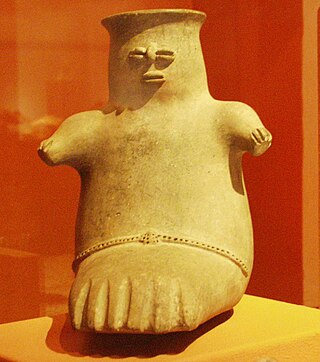
Chupícuaro is an important prehispanic archeological site from the late preclassical or formative period. The culture that takes its name from the site dates to 400 BC to 200 AD, or alternatively 500 BC to 300 AD., although some academics suggest an origin as early as 800 BC.
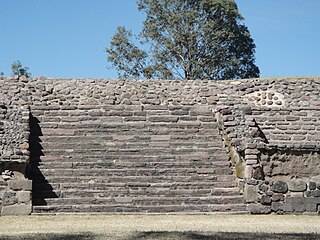
El Conde is an archeological site located at Ozumba Street, El Conde, three block north the Mayo 1 Ave., in the municipality of Naucalpan, Mexico State.
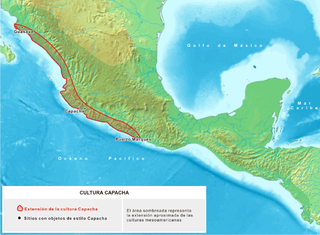
Capacha is an archaeological site located about 6 kilometers northeast of the Colima Municipality, in the Mexican state of Colima. This site is the heart of the ancient Mesoamerican Capacha Culture.




















